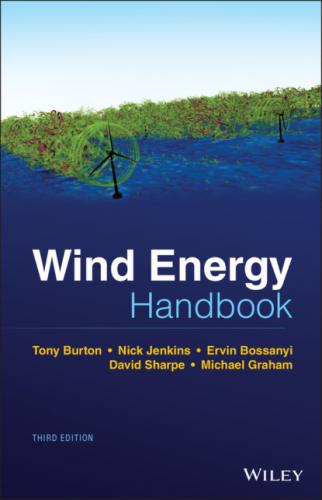A3.8 Aerofoil drag characteristics
The definition of the drag coefficient for a streamlined body, such as an aircraft wing or a wind turbine blade, because of the relevance of surface friction drag is based not on the frontal area but on the plan area. The flow past a body that has a large span normal to the flow direction is locally quasi‐2‐D, and in such cases the drag coefficient can be based upon the drag force per unit span using the streamwise chord length for the definition:
(A3.7)
The drag coefficient of an aerofoil varies with angle of attack. For a well‐designed aerofoil at moderate to high Reynolds number [O(106)–O(107)], the value of Cd is O(0.01) in the minimum drag range of angle of attack (called the drag bucket).
The following sections show some results for two classical NACA four‐digit aerofoils that, although not now used except exceptionally for wind turbines, do demonstrate the typical force behaviour of aerofoil sections.
A3.8.1 Symmetric aerofoils
Figure A3.11 shows that on the upper surface pressure is rising as the flow moves from the suction peak towards the trailing edge. This is an adverse pressure gradient that slows the air down. It also thickens the boundary layer more rapidly, causing more velocity momentum to be lost. If the flow above (i.e. just off) the surface within the boundary layer is slowed to a standstill, the surface streamlines separate from the surface, stall occurs, and the pressure drag rises sharply. The strength of the adverse pressure gradient increases with angle of attack, and therefore the drag will also rise with angle of attack. Figure A3.14 shows the variation of Cd with α for the symmetrical NACA0012 aerofoil.
Figure A3.14 Variationof Cd with α for the NACA0012 aerofoil.
Figure A3.15 Lift/drag ratio variation for the NACA0012 aerofoil.
The efficiency of a wind turbine rotor blade is significantly affected by the lift/drag ratio of its aerofoil section(s) (as shown in Figure A3.15), and it is desirable that a turbine blade operates at the maximum ratio point.
The nature of the flow pattern around an aerofoil is determined by the Reynolds number, and this affects the values of the lift and drag coefficients. The general level of the drag coefficient increases with decreasing Reynolds number. The effect on the lift coefficient is largely concerned with the angle of attack at which stall occurs. Below a critical Reynolds number of about 200 000, the boundary layer remains laminar, usually leading to early stall or partial separation (long bubbles) at low angles of attack.. As the Reynolds number rises, so does the stall angle and, because the lift coefficient increases linearly with angle of attack below the stall, the maximum value of the lift coefficient also rises.
Figure A3.16 Variation of the drag coefficient with Reynolds number at low angles of attack.
Characteristics for the NACA0012 aerofoil are shown in Figures A3.16 and A3.17.
A3.8.2 Cambered aerofoils
Cambered aerofoils, such as the NACA4412 shown in Figure A3.18, like cambered plates have curved mean lines, and this allows them to produce lift at zero angle of attack.
Generally, cambered aerofoils have their minimum drag range (drag bucket) at angles of attack well above zero. Thus, they are able to attain higher maximum lift/drag ratios than symmetrical aerofoils for positive angles of attack and useful lift coefficients, and this is the reason for their use.
The classification of the NACA four‐digit range of aerofoils, which were commonly used on earlier wind turbines, is very simple and is illustrated in Figure A3.19: from left to right, the first digit represents the amount of camber as a percentage of the chord length, the second digit represents the percentage chord position, in units of 10%, at which the maximum camber occurs, and the last two digits are the maximum thickness to chord ratio, as a percentage of the chord length, which, in this family of aerofoils, is at the 30% chord position. The cambered mean line, called the camber line, comprises two parabolic arcs that join smoothly at the point of maximum camber. For details of the extensive range of five‐ and six‐digit NACA aerofoils the reader should refer to Theory of Wing Sections by Abbott and von Doenhoff (1959).
Figure A3.17 Variation of the drag and lift coefficients with Reynolds number in the stall region.
Figure A3.18 The profile of the NACA4412 aerofoil.
The angle of attack α is measured from the chord line, which is now defined as the straight line joining the ends of the camber line.
